GlucaGen
Generic name: glucagon (injection)
What is GlucaGen?
GlucaGennis a prescription medicine used to treat very low blood sugar (severe hypoglycemia) in people with diabetes who use insulin.
Description
Glucagon is an antihypoglycemic agent and a gastrointestinal motility inhibitor. It is produced by expression of recombinant DNA in a Saccharomyces cerevisiae vector with subsequent purification. The chemical structure of the glucagon is identical to human glucagon. Glucagon with the empirical formula of C153H225N43O49S, and a molecular weight of 3483, is a single-chain polypeptide containing 29 amino acid residues. The structure of glucagon is:
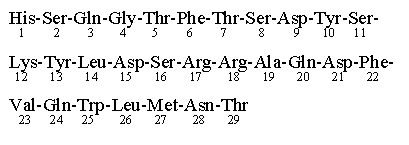
GlucaGen is a sterile, lyophilized white powder for reconstitution for subcutaneous, intramuscular or intravenous use, supplied in a 2 mL vial (appearance of the powder may vary, and occasionally the powder may appear compacted). Each vial for reconstitution contains 1 mg of glucagon, 107 mg of lactose monohydrate, hydrochloric acid and sodium hydroxide. Hydrochloric acid and/or sodium hydroxide may be used to adjust the pH before lyophilization. The reconstituted solution of GlucaGen contains glucagon 1 mg/mL at pH 2.5-3.5, and is soluble in water.
Who should not use GlucaGen?
Do not use GlucaGen if:
- you are allergic to glucagon or lactose or any of the ingredients in GlucaGen.
- See the end of this Patient Information leaflet for a complete list of ingredients in GlucaGen.
- you have a tumor in the gland on top of your kidneys (adrenal gland) called a pheochromocytoma.
- you have a tumor in your pancreas called an insulinoma.
What should I tell my healthcare provider before using GlucaGen?
Before using GlucaGen, tell your doctor about all of your medical conditions, including if you:
- have kidney problems.
- have pancreas problems. Tumors in your pancreas called glucagonomas.
- have not had food or water for a long time (prolonged fasting or starvation).
- have low blood sugar that does not go away (chronic hypoglycemia).
- have heart problems.
- are pregnant or plan to become pregnant.
- are breastfeeding or plan to breastfeed. It is not known if GlucaGen passes into your breast milk.
Tell your doctor about all the medicines you take, including prescription and over the counter medicines, vitamins and herbal supplements. GlucaGen may affect the way other medicines work, and other medicines may affect how GlucaGen works. Know the medicines you take. Keep a list of them to show your doctor and pharmacist when you get a new medicine.
How should I use GlucaGen?
- Read the detailed Instructions for Use that come with GlucaGen.
- Use GlucaGen exactly as your doctor tells you to.
- Make sure that you and your family know how to use GlucaGen the right way before you need it.
- Act quickly. Having very low blood sugar for a period of time may be harmful.
- Call for emergency medical help right after you use GlucaGen.
- Eat sugar or a sugar-sweetened product such as a regular soft drink or fruit juice as soon as you are able to swallow.
- Tell your doctor each time you use GlucaGen. Your doctor may need to change the dose of your diabetes medicines.
What should I avoid while using GlucaGen?
While using GlucaGen do not:
- drive or operate machinery until you have eaten sugar or a sugar-sweetened product such as a regular soft drink or fruit juice.
What are the possible side effects of GlucaGen?
GlucaGen may cause serious side effects, including:
- High blood pressure. High blood pressure is common after taking GlucaGen and can be severe.
- Low blood sugar. GlucaGen can cause low blood sugar in patients with tumors in their pancreas called insulinomas and glucagonomas by making too much insulin in their bodies.
- Allergic reactions. Symptoms of a serious allergic reaction to GlucaGen may include rash, difficulty breathing, or low blood pressure (hypotension).
The most common side effects of GlucaGen include:
- nausea
- vomiting
- temporary fast heartbeat or pounding in your chest (tachycardia).
Tell your doctor if you have any side effect that bothers you or that does not go away. These are not all the possible side effects of GlucaGen. For more information, ask your doctor or pharmacist. Call your doctor for medical advice about side effects. You may report side effects to FDA at 1-800-FDA-1088.
General information about the safe and effective use of GlucaGen
Medicines are sometimes prescribed for purposes other than those listed in a Patient Information leaflet. Do not use GlucaGen for a condition for which it was not prescribed. Do not give GlucaGen to other people, even if they have the same symptoms that you have. It may harm them. You can ask your pharmacist or healthcare provider for information about GlucaGen that is written for health professionals.
How should I store GlucaGen?
Before you mix the GlucaGen powder and liquid:
- Store GlucaGen at room temperature between 68°F to 77°F (20°C to 25°C) for up to 24 months (2 years).
- Check the expiration date on your vial of GlucaGen. Do not use GlucaGen if the expiration date has passed.
- Do not freeze GlucaGen.
- Keep GlucaGen in its original package, and keep GlucaGen out of light.
After you mix the GlucaGen powder and liquid:
- Use GlucaGen right away.
- Throw away any unused GlucaGen.
- Do not use GlucaGen if a gel has formed, or if you see particles in the solution.
Keep GlucaGen and all medicines out of the reach of children.
Label
- NDC 0169-7065-15
- GlucaGen® HypoKit
- (glucagon) for injection
- Emergency Use for Low Blood Sugar
- 1 mg per vial
- Single use only. Discard unused portion.
- Protect from light
- Rx only
- Novo Nordisk Inc.
- Plainsboro, NJ 08536
- www.novonordisk-us.com
- 1-800-727-6500
- Manufactured by:
- Novo Nordisk A/S
- 2880 Bagsvaerd, Denmark

What are the ingredients in GlucaGen?
Active Ingredient: glucagon
Inactive ingredients: lactose monohydrate and sterile water for reconstitution
How to use GlucaGen injection
Supplies you will need for your GlucaGen injection (See Figure A):
- 1 GlucaGen HypoKit that contains:
- 1 single-dose vial that contains 1 mg of GlucaGen powder (glucagon) for injection and 1 prefilled syringe with attached needle that contains 1 mL of sterile water.

- •
- 1 puncture-resistant container for throwing away used needles and syringes. See “How should I dispose of (throw away) used GlucaGen prefilled syringes” at the end of these instructions.
Preparing the GlucaGen dose:
- •
- The GlucaGen medicine comes as a dry powder. Before you use GlucaGen, you must mix the dry powder with the syringe of sterile water that comes in the GlucaGen Hypokit. Do not use any other liquid to mix the medicine.
- •
- Check that the orange plastic cap on your vial of GlucaGen is firmly attached. Do not use the vial of GlucaGen if the orange plastic cap is loose or missing.
Step 1. Using your thumb, flip the orange plastic cap off the GlucaGen vial (See Figure B).

Step 2. Pick up the prefilled syringe containing sterile water. Hold the syringe with 1 hand and with your other hand, pull the needle cover off the syringe (See Figure C).
- •
- Do not remove the plastic backstop from the syringe.

Step 3. Pick up the GlucaGen vial. Hold the vial of dry powder with 1 hand and with your other hand, push the needle of the prefilled syringe through the center of the rubber stopper (See Figure D).
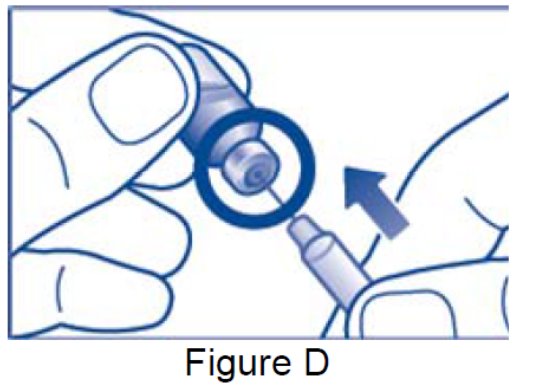
Step 4. Hold the vial and syringe together, with the needle still inserted into the vial. Carefully turn the vial and syringe together right side up. Slowly push the plunger down until the syringe is empty (See Figure E).
- •
- Do not take the syringe out of the vial.
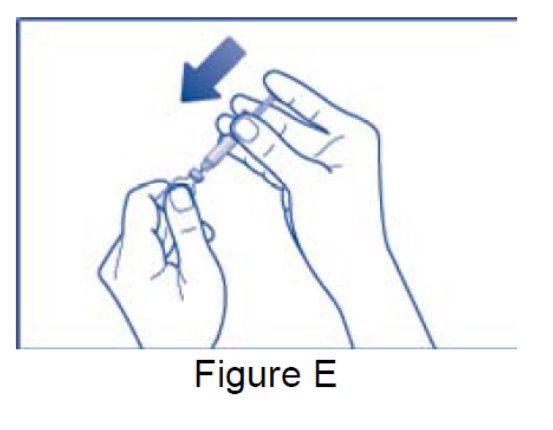
Step 5. Hold the entire unit (the vial and syringe) in one hand and gently shake the vial until the powder is completely dissolved (See Figure F).
- •
- Do not use if a gel has formed, or if you see particles in the solution.
- •
- Do not take the syringe out of the vial.
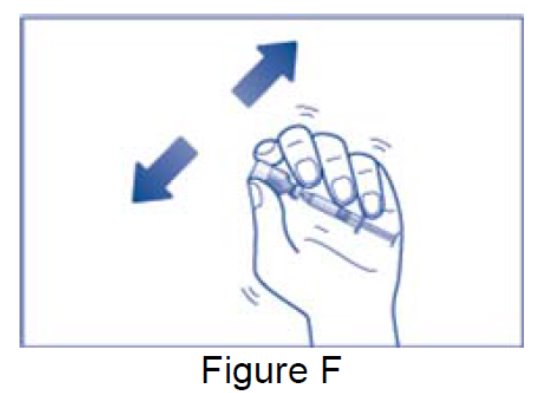
Step 6. Firmly hold the vial and syringe together, with the needle still inserted into the vial. Carefully turn the vial and syringe together upside down. Gently pull down on the plunger and slowly withdraw all of the liquid into the syringe (See Figure G).
- •
- Do not pull the plunger out of the syringe.

Step 7. Keep the needle inside the vial. Check the syringe for air bubbles. If you see bubbles, tap the syringe until the bubbles rise to the top of the syringe (See Figure H). Gently push on the plunger to move only the air bubbles back into the vial.
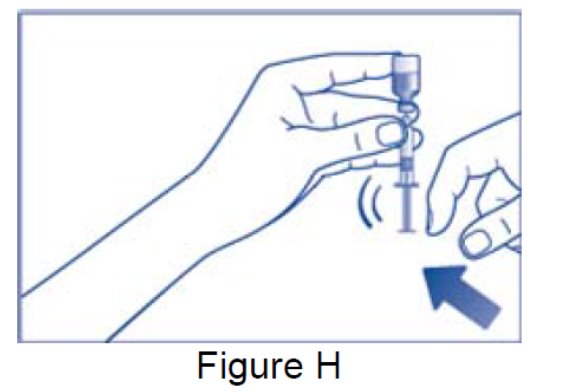
Step 8. Hold the vial and syringe as shown (See Figure I).
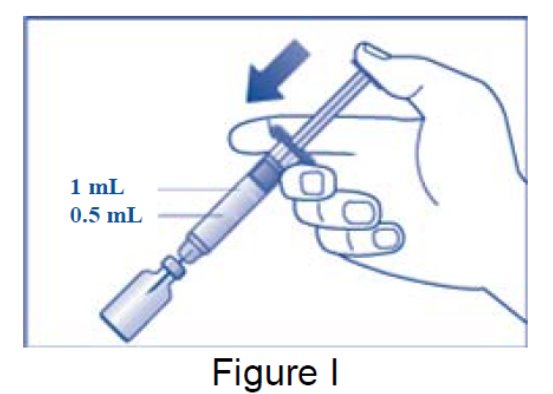
Take the syringe and needle out of the vial when the correct dose of GlucaGen is in the syringe. |
If you do not know how much the child weighs:
- •
- Give a child under 6 years of age 0.5 mg (0.5 mL).
- •
- Give a child 6 years of age and older 1 mg (1 mL).
Giving the GlucaGen injection:
Step 9. Choose the injection site (See Figure J).
Common injection sites for GlucaGen are upper arms, thighs, or buttocks.

Step 10. With one hand gently pinch the skin at the injection site. With your other hand insert the needle into the skin and push the syringe plunger down until the syringe is empty (See Figure K).
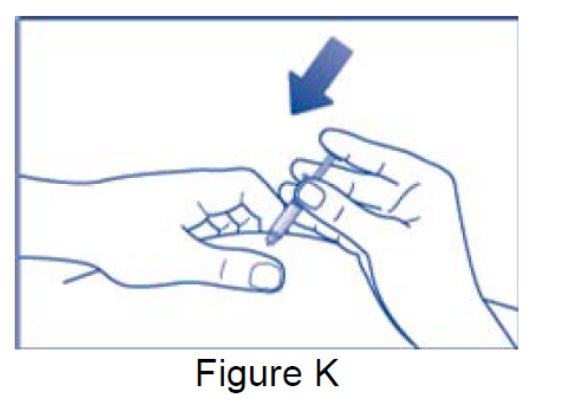
After Giving the GlucaGen injection:
Step 11. Pull the needle out of the skin and press on the injection site (See Figure L).
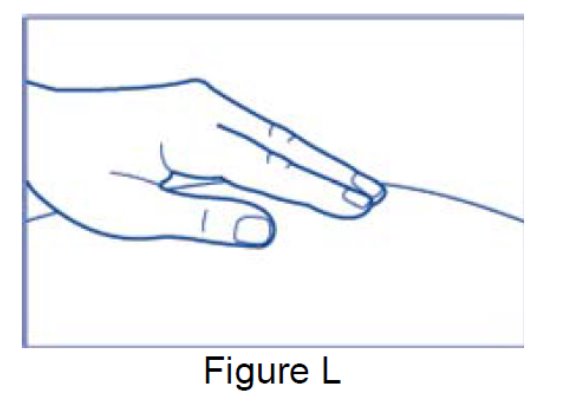
Throw away your used syringe with the needle attached and any GlucaGen you did not use. See “How should I dispose of (throw away) used GlucaGen prefilled syringes” at the end of these instructions.
Step 12. Turn the person on their side. When an unconscious person awakens, they may vomit. Turning the person on their side will lessen the chance of choking.
Step 13. Call for emergency medical help right away.
Step 14. Feed the person as soon as they are awake and able to swallow.
Give the person a fast-acting source of sugar (such as a regular soft drink or fruit juice) and a long-acting source of sugar (such as crackers and cheese or a meat sandwich).
Step 15. If the patient does not awaken within 15 minutes, give another dose of GlucaGen. Call your doctor and get emergency help right away.
Step 16. Even if the GlucaGen treatment wakes the person, tell their doctor right away. The doctor should be told whenever a severe drop in blood sugar (hypoglycemia reaction) happens. The person’s dose of diabetes medicine may need to be changed.
Hypoglycemia may happen again after receiving GlucaGen treatment.
Early symptoms of hypoglycemia may include:
|
|
If not treated early, hypoglycemia may worsen and the person may have severe hypoglycemia. Signs of severe hypoglycemia include:
- •
- confusion
- •
- unconsciousness
- •
- seizures
- •
- death
How should I dispose of (throw away) GlucaGen pre-filled syringes?
- •
- Put used syringes in a FDA-cleared sharps disposal container right away after use. Do not throw away (dispose of) loose needles and syringes in your household trash.
- •
- If you do not have a FDA-cleared sharps disposal container, you may use a household container that is:
- made of a heavy-duty plastic,
- can be closed with a tight-fitting, puncture-resistant lid, without sharps being able to come out,
- be upright and stable during use,
- leak-resistant, and properly labeled to warn of hazardous waste inside the container.
- •
- When your sharps disposal container is almost full, you will need to follow your community guidelines for the right way to dispose of your sharps disposal container. There may be state or local laws about how you should throw away used needles and syringes. For more information about safe sharps disposal, and for specific information about sharps disposal in the state that you live in, go to the FDA’s website at: HTTP://WWW.FDA.GOV/SAFESHARPSDISPOSAL.
- •
- Do not dispose of your used sharps disposal container in your household trash unless your community guidelines permit this. Do not recycle your used sharps disposal container.
Keep GlucaGen and all medicines out of the reach of children.
This Instructions for Use has been approved by the U.S. Food and Drug Administration.
SRC: NLM.
